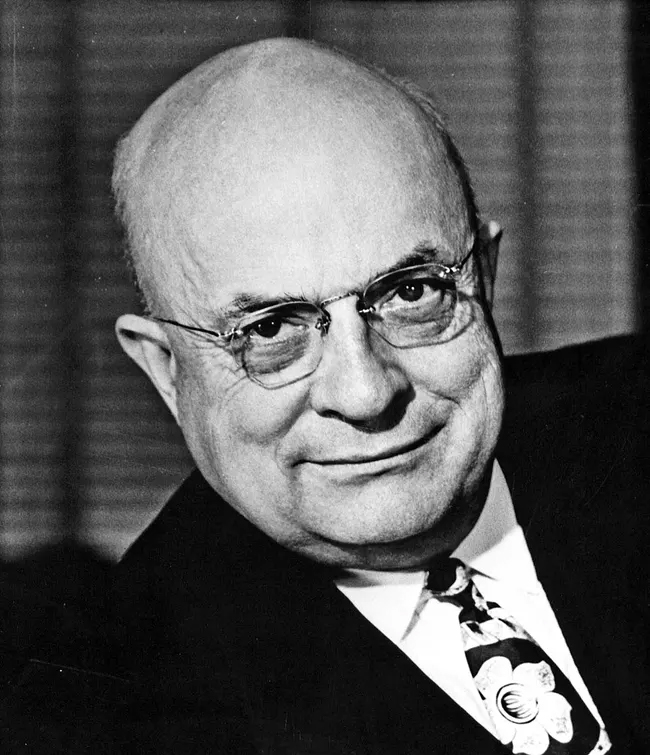Our Industry’s First Customer: Henry Kaiser, World War II Shipbuilder
We have all heard that our industry had its beginnings in the shipyards during World War II—but how did this happen? Henry J. Kaiser may be responsible.

Kaiser was an industrialist who gained notoriety in 1936 when he and his associates at Six Companies, Inc., completed the Hoover Dam some 2 years before its scheduled completion date. (He and his team certainly did not cut any corners as it remains strong and viable 88 years later!)
When the U.S. entered World War II, our Navy had only constructed 23 ships in the 1930s. A U.S. battleship took 230 days or 7½ months to build—and with a workforce of 40,000 in 1939, the country now needed thousands of ships. Based on his reputation as an innovator and an efficiency expert, Henry Kaiser and his company were called into duty.
How large were these “Liberty Ships” that needed to be constructed in record numbers? Spanning 441 feet long and 56 feet wide, these vessels had a maximum tonnage of 9,000 tons with five cargo holds that could accommodate guns, ammunition, soldiers, and supplies with airplanes, tanks, and even locomotives secured to the top deck.
Kaiser began planning and creating the infrastructure for a ship-building operation in Richmond, California, a small San Francisco Bay area community about 18 miles by ferry from San Francisco. The pre-war population of Richmond was 20,000. This number soon swelled to 120,000 as construction began. There was a need for housing, schools, and shopping.
Kaiser’s master plan was to assemble the hull of each battleship and then create an assembly-line building process onboard the ship. With thousands of workers needed—most untrained and unskilled—he worked to simplify the production methods so basic construction skills could be mastered quickly and efficiently.

Kaiser constantly refined his plans, saving time and increasing efficiency. The first Liberty Ship was constructed in 124 days! Soon they were building a ship every 39 days. As a publicity stunt, the record was 4 days, 15 hours, and 27 minutes. One of the catchphrases at that time was to “build ships quicker than the Japanese can sink them.”
How could they produce more and more ships? With more and more men being drafted, Kaiser did the unthinkable at that time and hired women. Eventually, 30% of the workforce was female. In addition, he hired wounded veterans, individuals with physical disabilities, and anyone who wanted to work to win the war.

Among his methods for maintaining quality while increasing production, Kaiser instituted welding of sheet metal as opposed to riveting. It took an average of 6 months to become a qualified riveter while welding could be mastered in roughly 2 weeks. With the huge influx of new workers constantly being brought onboard, the plan ensured that the new workers could be productive faster.
An interesting note: “Rosie the Riveter” was a popular recruiting figure for the war, but riveting was for airplanes only. The government created “Wendy the Welder” to recruit for the shipbuilding industry, but it was never rose to “Rosie’s” popularity.
Kaiser soon opened three more yards in Richmond and one in Portland, Oregon. When all shipyards were in full operation, Kaiser and his team completed one ship a day!
As World War II came to an end, U.S. shipyards produced 2,751 Liberty Ships with an astounding 1,552 (56%) coming from Kaiser’s team. Of all U.S. maritime vessels produced during the war, Kaiser was responsible for 30%.

A Better Appreciation for the Birth of Our Industry
It is not hard to imagine that Kaiser needed new ways to save valuable minutes for thousands of workers. Creating the demand for efficient portable sanitation in immediate proximity to the job site was critical. According to a newspaper article in The Des Moines Register on July 16, 1993, John Taylor (then Executive Vice President for Satellite Industries) said:
“As the story goes, after industrialist Henry Kaiser complained, a small septic tank company put together a privacy structure out of plywood and cut in half a 55-gallon drum for the waste receptacle. By 1950, the company had about 12,000 portable units serving Southern California’s housing boom.”
If we only had the name of that “small septic company,” we might have the name of the first portable restroom company in the world!
It is now easy to see how our industry began to flourish. As the number of ships under construction increased, so did the demand for portable restrooms. The early restroom operators had to build more and more wooden portables and to service the ever-increasing number of units. Like Kaiser’s innovative construction methods, our industry blossomed in this thriving environment.
We now know the identity of customer #0001 for our industry!
Notice the portable restroom unit at the front of the ship for easy accessibility. Steps were needed to enter the unit as it was built on top of the 55-gallon drum waste collector below.

One final note: Kaiser supported schools, housing, and healthcare facilities for his employees and their families. After the War, Kaiser privatized these healthcare facilities and made them available to the public. You may be familiar with these medical centers 89 years later: Kaiser Permanente.
For even more interesting facts about the history of our Industry and of our Association, click on the links below and order your History Book. All proceeds benefit the PSAI Scholarship Program.
